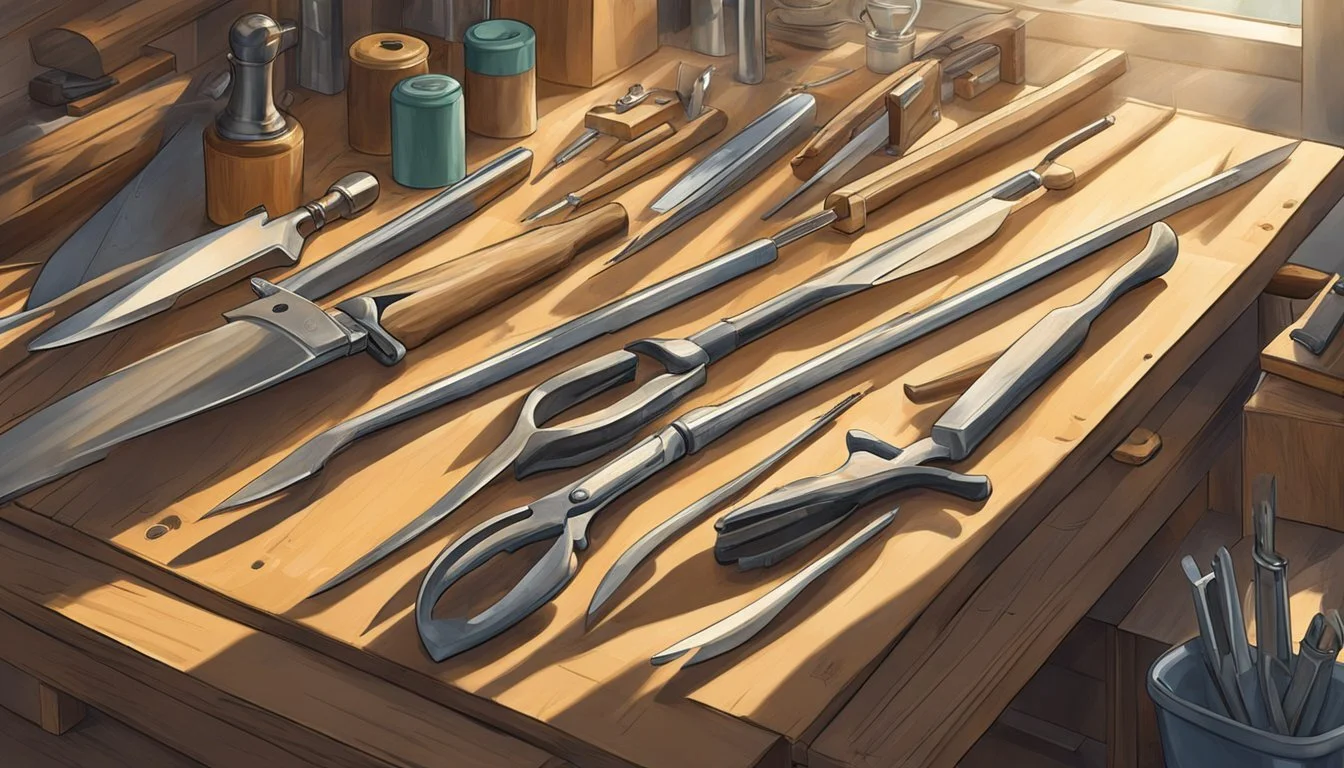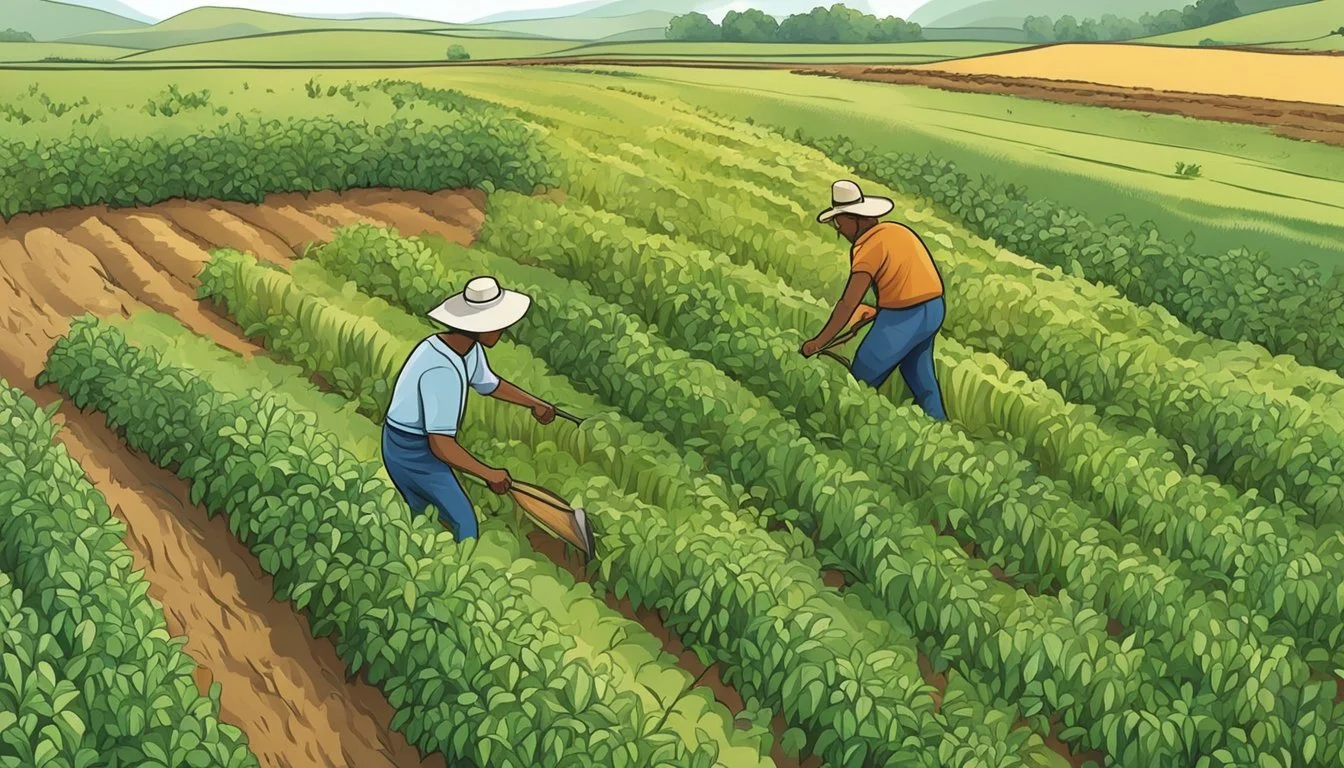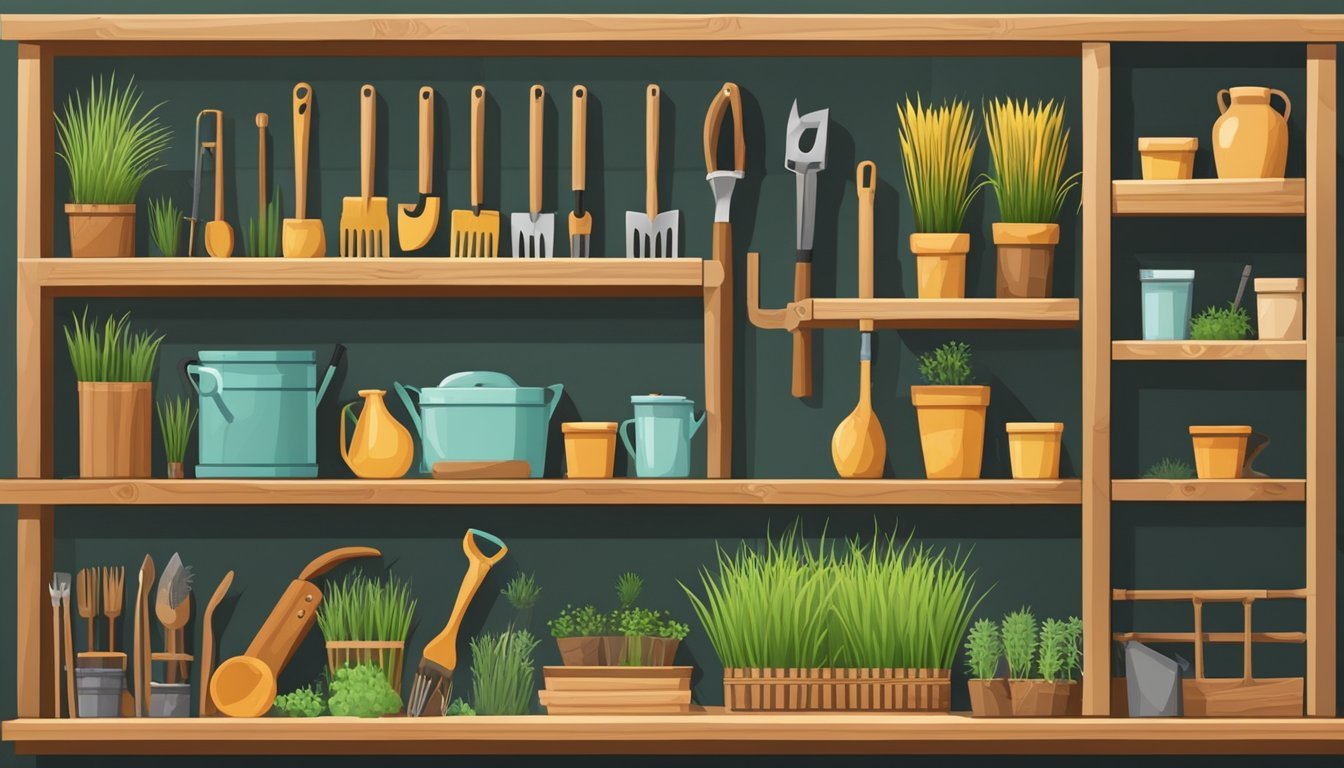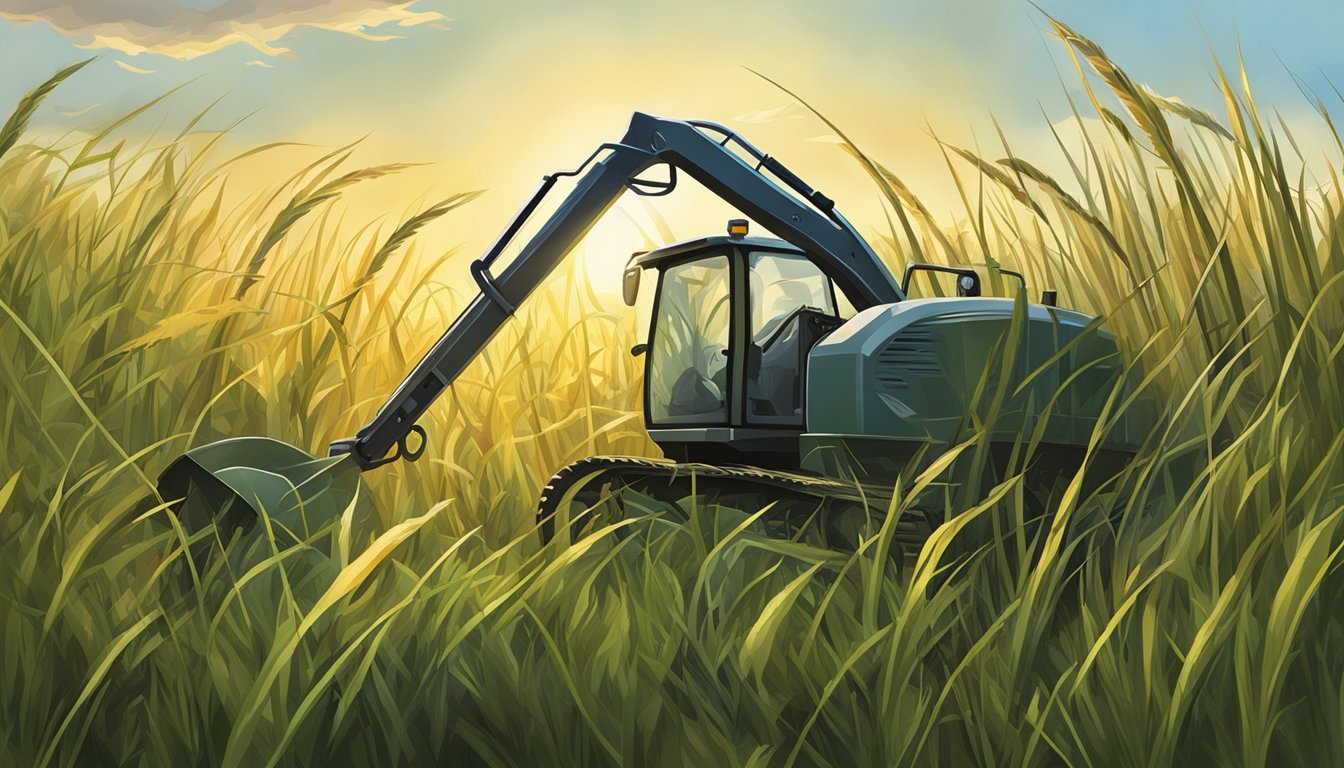The Ultimate Guide to Using a Sickle
Master Hand-Harvesting and Grass Cutting Techniques
A sickle is a hand-held agricultural tool with a curved blade, optimized for efficiency in harvesting crops or cutting grass. It remains an essential tool for many homesteaders who appreciate the control and precision it provides. When wielded properly, a sickle can be used to hand-harvest various crops, especially grains, and for managing overgrowth and maintaining pasture edges.
Efficient hand-harvesting and grass cutting with a sickle require technique and practice. The tool's design ensures that with the correct motion, one can cut close to the ground or to the stems of crops with minimal effort. This traditional method is still favored on many homesteads due to its cost-effectiveness and the low environmental impact, conserving the tranquility of the rural setting without the noise and fuel emissions of powered machinery.
Homesteaders opt for a sickle for its versatility. Beyond harvesting and grass cutting, the sickle can be effectively employed in the selective trimming of plants to encourage growth or to clear an area for new planting. Despite the advancements in agricultural technology, the sickle endures as an invaluable asset for efficient, manual crop management and land maintenance.
History and Evolution of the Sickle
The sickle is a hand-held agricultural tool with a curved blade used for millennia in harvesting and land management. This section will explore its journey from primitive materials to modern-day steel and its relative use compared to other harvesting tools.
From Stone to Steel: The Development of Sickles
The sickle's origins can be traced back to prehistoric times with implements made from flint and bone. As they evolved, metal blades came into use, vastly improving their durability and efficiency in cutting. The construction of a sickle is fairly simplistic: a typically curved, sharp-edged blade is fixed to a short wooden handle, enabling a hand-powered cutting motion.
Materials Over Time:
Stone Age: Flint, bone
Bronze Age: Bronze
Iron Age Onward: Iron, steel
During agricultural progress, sickles transitioned through various material phases, with the most significant leap occurring with the advent of hardened steel. Current sickles often employ robust materials such as this for the blade, sometimes paired with ergonomic handles of plastic or composite materials, providing both durability and comfort to the user.
Comparison with Scythes and Other Harvesting Tools
Sickles and scythes are easily confused due to their similar applications but differ significantly in design and usage. The sickle is designed for small-scale, precise cutting, usually while stooping or squatting. It's particularly effective for tight spaces where a larger tool wouldn't be practical.
Sickle vs. Scythe:
Sickle: Handle Length - Short, Stance During Use - Stooping or squatting, Cutting Motion - Short, hand-powered
Scythe: Handle Length - Long, Stance During Use - Upright, Cutting Motion - Long, sweeping
Scythes, on the other hand, have longer handles and are meant for mowing larger areas and standing crops, enabling the user to remain upright. The longer, sweeping motion is more efficient over wide expanses but lacks the sickle's precision. Both tools are pivotal hand tools in agriculture, but their usage is determined by the scale and specifics of the task at hand. While mechanization has introduced more advanced tools, the sickle remains relevant for its simplicty, cost-effectiveness, and ability to manage spaces where machinery cannot operate.
Anatomy of a Sickle
The sickle, an integral tool for manual harvesting and grass cutting, consists of two main components: the blade and the handle. These parts are designed for durability and efficiency in various agricultural tasks.
Examining the Sickle’s Blade and Handle
The sickle’s blade is typically curved, which allows it to slice through vegetation with a minimal effort. The curvature ensures an efficient cutting motion when the user swings the tool across the base of the plants.
Blade Shape: Curved for efficient cutting
Blade Function: Slices through vegetation
The handle serves as the point of control for the user, dictating the sickle’s motion and balance during use. Handles may be constructed from wood or plastic, each providing a unique weight and grip experience for the user.
Handle Material: Wood or plastic
Handle Function: Provides control and balance
Material Considerations for Durability and Efficiency
Materials used in the construction of a sickle affect its longevity and functionality. A blade forged from hardened steel can offer a sharp, durable edge suitable for repetitive cutting, while the choice of a wooden or plastic handle influences the tool's ergonomics and user fatigue during prolonged use.
Blade Material: Hardened steel
Handle Material: Wood for traditional feel, plastic for lightweight ergonomics
The equipment's performance is enhanced when materials are chosen for their specific qualities, such as rust resistance and comfort, ensuring a tool that is both sturdy and practical for the tasks at hand.
Selecting the Right Sickle for Your Needs
Choosing the ideal sickle is critical to achieving efficiency and comfort in hand-harvesting and grass cutting. The selection process should focus on the plant type being harvested, the farm's size, and crop density.
Factors to Consider: Plant Type, Farm Size, and Crop Density
Plant Type: The plant type dictates the blade shape and sharpness. For instance, grain crops may require a sharp, finely-curved blade for clean cuts, while thicker stemmed plants may need a serrated edge for sawing.
Farm Size: A larger farm may benefit from multiple types of sickles to efficiently manage different areas and tasks. For smaller homesteads, a versatile sickle that can handle various plants may be more practical.
Crop Density: Densely planted crops demand a sickle that is easy to maneuver without damaging the plants. A shorter handle may offer greater control in tight spaces.
Sickle Varieties and Their Specific Uses
Harvesting Sickle: Typically features an 18-inch-long blade, suited for cutting and picking fruits and vegetables.
Weeding Sickle: Built with a shorter blade, perfect for tight and precise cuts to effectively manage weeds without harming neighboring crops.
Grass Sickle: Often equipped with a longer handle and a lightweight design to cover more area with reduced fatigue, ideal for mowing grass or trimming edges.
Traditional Sickle: Characterized by a curved blade attached to a short handle, used with one hand, commonly found with either smooth or serrated steel blades.
It is fundamental for farmers and gardeners to select a sickle that corresponds with their specific harvesting and grass-cutting needs to ensure that they work both effectively and safely.
Sharpening and Maintaining Your Sickle
Maintaining a sharp edge on a sickle is crucial for efficiency and safety in cutting. Regular maintenance also prolongs the equipment's lifespan, ensuring optimal performance.
Step-by-Step Guide to Sharpening
Inspect the Blade: Check the sickle's blade for nicks or dullness before starting the sharpening process.
Secure the Sickle: Stabilize the tool in a vise or by other means to keep it from moving during sharpening.
Choose the Right Stone: Employ a whetstone appropriate for the sickle's blade; a medium grit is generally recommended.
Sharpening Motion: Holding the stone at a consistent angle relative to the blade, slide the stone along the cutting edge in a single, fluid motion that follows the curve of the blade. Repeat this action multiple times, always moving the stone away from your body.
Check the Edge: After several passes with the stone, check the blade's sharpness. It should be keen enough to slice through grass and weeds with minimal effort.
Finishing Touches: Use a finer grit stone for the final few passes to polish and refine the edge.
Routine Maintenance Tips to Extend the Life of Your Sickle
Clean After Use: Wipe the sickle clean of plant residue and moisture after each use to prevent rust.
Dry Storage: Store the sickle in a dry place to further protect against corrosion.
Regular Inspections: Periodically inspect the handle and the blade for damage. Tighten any loose fittings and consider replacing the handle if it shows cracks or wear.
Oil the Blade: Lightly oiling the blade can prevent rust, especially if the sickle will be stored for an extended period.
Handle Care: Sanding any rough spots on the handle will maintain a comfortable grip and prevent blisters during use.
Through these steps, the sickle remains a dependable tool in the gardener's or homesteader's arsenal, ready for efficient harvesting and grass cutting tasks.
Techniques for Hand-Harvesting with a Sickle
Mastering the use of a sickle requires adopting correct techniques for efficiency and effectiveness. It's especially crucial when handling demanding tasks such as cutting wheat and rice, where precision in cutting and handling the stalks is key.
Optimal Stance and Posture for Cutting
One's stance is vital in minimizing effort and avoiding strain. The harvester should stand with their feet shoulder-width apart, knees slightly bent. This stance provides stability and flexibility. They should hold the sickle with a firm grip, the arm extended but not locked, positioning the body sideways to the line of cutting. This posture aligns the body correctly, allowing for a full range of motion while reducing fatigue.
Effective Swinging, Stalking and Bundling Methods
For the cutting phase, one should initiate a smooth, controlled swing. The motion should start from the shoulder, carrying through the arm, with the blade slicing close to the base of the stalks. A consistent rhythm helps maintain speed and efficiency. After cutting, stalks should be gathered into sheaves, ensuring the seeds are at one end.
Sheaves are then bundled using spare stalks or twine, wrapping the binding material around the gathered stalk with a twist and tuck method to secure it. Once bundled, sheaves are often stacked in a structured manner to promote air circulation for drying, which is a common practice in the harvesting of grains such as wheat and rice.
Applying these methods with a sickle allows the harvester to obtain clean cuts and well-organized bundles, streamlining the following stages of crop processing.
Understanding Harvesting Processes: Threshing to Winnowing
In the realm of manual harvesting, mastering the sequential steps from using a sickle for cutting to separating grain from chaff through winnowing is essential for efficiency and quality.
Preparing the Harvest: From Sickle Cutting to Threshing
A sickle, an ancient hand-held agricultural tool with a curved blade, is the starting point for harvesting. Its design allows for efficient slicing through cereal stems with minimal effort. Cutting should be done at ground level to maximize the harvest, and ensuring consistency in the motion aids in gathering the cut stalks into bundles, traditionally known as sheaves. Once gathered, sheaves are usually dried and then prepared for threshing.
Threshing is the process of loosening the edible part of cereal grain or other crops from the inedible chaff that surrounds it. It can be done manually by beating the sheaves against a hard surface or using a more mechanized approach if available. The aim is to separate the valuable grain while preserving its quality, and every stroke should be both firm and controlled to minimize grain damage.
Traditional Winnowing Techniques Post-Harvest
After threshing, what remains is a mixture of grain and the lighter, inedible chaff. Winnowing is the next critical stage, where separation occurs. It traditionally involves tossing the mixture into the air so that the wind can blow away the lighter chaff, leaving the heavier grains to fall back into the collection area.
Key to effective winnowing is a steady, but not overpowering, breeze. Without the aid of mechanical systems, farmers rely on the natural wind, or they create air flow with fans or by simply waving a sheet. The process is repeated until the grain is clean and free of debris. This painstaking attention to detail ensures that only the purest grain is stored or taken to market.
By understanding and applying these age-old processes of threshing and winnowing, one can harvest and process grains with a significant degree of self-sufficiency and connection to traditional agricultural practices.
Utilizing the Sickle in Modern Farming Practices
In the realm of contemporary agriculture, the sickle serves as a complement to modern machinery, offering a blend of traditional and mechanized methods for crop management and harvesting.
Integration with Mechanical Tools and Equipment
When integrated with mechanical tools, the sickle provides a unique benefit for specific farming tasks. Farmers often use sickles for precision work where larger equipment like mechanical threshers and combines cannot operate efficiently due to space constraints or where the delicacy of the harvested crop is a concern. For instance, in tight rows between plants or along the edges of fields, a sickle allows for careful cutting without disturbing the surrounding area. As equipment handles the bulk work, sickles are used for threshing leftover crops or for the initial cutting before larger machines pass through.
Comparison of Hand-Harvesting to Mechanical Harvesting
Hand-harvesting with a sickle can be contrasted with mechanical harvesting in terms of its impact on the crop and efficiency.
Crop Impact
Hand-Harvesting: Minimizes damage to plants, suitable for delicate crops.
Mechanical Harvesting: Higher risk of damage, efficient for robust crops.
Efficiency
Hand-Harvesting: Labor-intensive and time-consuming, yet provides a higher level of control.
Mechanical Harvesting: Significantly faster, can handle vast areas quickly, but may require additional passes to collect all produce.
While a sickle does not match the speed of a combine, it can protect the integrity of the harvested crop, making it indispensable for farmers who prioritize crop quality and those with smaller or specialized plots.
Special Considerations for Various Crops
When dealing with different types of crops, it's crucial to adapt the sickle harvesting technique to maximize efficiency and reduce crop damage. Each crop variety presents unique challenges and requires a specific approach to hand-harvesting.
Harvesting Techniques for Grains like Barley and Oat
For grains such as barley and oat, the sickle should be used with precision to maintain the integrity of the stalks and grains. They typically prefer:
Cutting Angle: A sharp angle close to the ground to optimize the yield.
Cutting Height: Keeping the height consistent to prevent loss of grains and ensure even drying if they are to be windrowed.
Barley often has a tough stem, which means a sickle with a serrated edge might be beneficial to ease the cutting process. Whereas, oat may need a smoother cut to avoid damaging the softer stems. For both crops, employ a rhythmic side-to-side motion to maintain efficiency.
Guidelines for Specialty Crops: Saffron, Vanilla, and Cotton
The sickle approach must be adapted even more when dealing with specialty crops like saffron, vanilla, and cotton, due to their unique harvesting requirements.
Saffron: This crop is produced from the stigmas of Crocus sativus flowers and requires delicate handling.
Sickle Use: Generally not recommended, but if used, it should be for the minimal cutting of flower stems.
Vanilla: Orchid pods of the plant need to be handpicked, so the use of a sickle is limited to maintenance.
Site Management: Cutting back other vegetation without harming the vanilla vines.
Cotton: It needs to be plucked when the bolls burst open.
Field Preparation: A sickle may clear the vegetation around the cotton plants before the bolls open.
When crops like rice are lodged, or knocked over, a sickle can be particularly handy in salvaging the produce. Careful, low-to-ground cutting helps recover what might be lost in machine harvesting. Each crop's conditions—such as moisture levels and stem brittleness—must be considered to minimize damage during the harvesting process.
Safety Measures and Ergonomic Practices
When using a sickle for hand-harvesting and grass cutting, implementing safety measures and ergonomic practices is crucial to prevent injury and enhance efficiency.
Personal Protective Equipment (PPE):
Gloves: Wear thick gloves to protect hands from blisters and cuts.
Footwear: Use sturdy boots to safeguard feet against accidental sickle cuts.
Eye Protection: Wear safety glasses to prevent debris from injuring the eyes.
Sickle Handling:
Grip: Hold the sickle firmly with a relaxed wrist to minimize strain.
Posture: Maintain a straight back to avoid stress on the spine.
Motion: Use smooth, controlled strokes; do not twist the wrist excessively.
Ergonomic Tool Use:
Maintenance: Keep the sickle sharp as a blunt blade requires more force.
Selection: Choose a sickle with an adjustable handle to fit individual height and reach.
Rest: Take regular breaks to rest muscles and prevent overexertion.
Proper Techniques:
Cutting: Slice close to the ground at a consistent angle for uniform cuts.
Lifting: Bend at the knees, not the waist, when picking up sheaves of cut material.
Safety Protocols:
Store the sickle in a safe place when not in use, ideally in a sheath.
Familiarize oneself with first-aid procedures in case of an accident.
Ensure clear communication with nearby individuals to maintain a safe working perimeter.
By adhering to these safety measures and ergonomic practices, one can minimize the risk of accidents and health issues, thereby ensuring a more productive and sustainable work environment.
Storing and Organizing Harvest Tools
Proper organization and maintenance of harvest tools, such as sickles, knives, and hoes, can significantly enhance their longevity and ensure they are ready for use when needed. This section provides a structured approach to storing and managing these essential tools for small-scale farmers.
Proper Cleaning and Storage Solutions
Prior to storage, it is crucial that hand tools are thoroughly cleaned to remove soil and plant residue. A stiff brush and water often suffice, but a mild disinfectant can be used for tools like knives and sickles to prevent disease spread. After cleaning, tools should be dried completely to prevent rust.
For storage, hang tools like sickles, hoes, and forks on a pegboard or in a storage rack, which keeps them off the ground and prevents damage. Buckets can store smaller tools and attachments, ensuring they are easily accessible. Equipment such as shocks can be collapsed or disassembled for compact storage if they are not in use.
Ensure sharp tools, such as knives and sickle blades, are sheathed or placed in a secure position to avoid injury when not in use. For long-term storage, especially over winter, coating metal parts with a light oil can help prevent rust and corrosion.
Inventory Management for Small-Scale Farmers
Keeping an inventory is integral to efficient farm management. A simple spreadsheet or chart can be employed to track all harvest tools, including the quantity and condition of each item. For example:
Sickle: Quantity - 3, Condition - Good
Knives: Quantity - 5, Condition - Needs sharpening
Hoe: Quantity - 2, Condition - Excellent
Forks: Quantity - 4, Condition - Good
Regular inspections will ensure that equipment is in working order and any necessary maintenance, such as sharpening or replacing handles, is scheduled. This proactive approach helps farmers avoid the inconvenience and potential costs associated with tool failure during critical times of the harvest season.
Creative Uses for Sickles Beyond Harvesting
Sickles are traditional tools known for their curved blades and efficiency in harvesting crops. However, their utility extends into various gardening and landscaping tasks. They become particularly valuable in managing outdoor spaces where precision and delicate handling are necessary.
Landscaping: Gardeners can shape bushes and remove unwanted vegetation with a sickle. Its sharp edge is ideal for sculpting greenery and creating clear lines in the landscape design.
Grass Cutting: In areas where lawnmowers are impractical, sickles serve as an excellent alternative for cutting grass. They are particularly useful for trimming edges and corners, maintaining a tidy appearance along walkways and fences.
Gardening Tasks:
Thinning Seedlings: A sickle can thin overcrowded seedbeds, carefully slicing through unwanted sprouts.
Pruning: Small branches and stems can be pruned with a swift motion, promoting plant health.
Pruning: Sickle Type - Short-handled, Description - Allows for close-up, precise cuts on plants.
Grass Edging: Sickle Type - Serrated blade, Description - Offers clean cuts along borders and tight spaces.
Shaping Bushes: Sickle Type - Long curved blade, Description - Facilitates the creation of smooth, curved lines in the foliage.
Gardeners who master the sickle introduce an element of traditional craftsmanship into their routine, blending historic tools with modern gardening practices. By adopting a confident approach, gardeners can explore these creative applications, enhancing their homestead's beauty and productivity.
Conclusion
Utilizing a sickle effectively is an essential skill for any homesteader seeking to harvest crops or manage grassy areas manually. It's imperative that users handle the tool with care, maintaining a firm grip and a stable stance to ensure precision. Regular practice allows one to develop a steady rhythm, which is crucial for both efficiency and safety when cutting.
The sickle's simple design belies its versatility. An adept user can employ it not only for harvesting grain but also for trimming overgrowth and general garden maintenance. By using sharp, consistent strokes, one can achieve a clean cut with minimal effort. Gardeners should remember to protect the sickle's blade and clean it after each use to prolong its life.
Maintenance Tips:
Clean the blade after each use to prevent rust.
Sharpen the blade regularly for optimal performance.
Moreover, choosing the right sickle is just as important as mastering its use. One should select a size and shape that suits their specific tasks and individual comfort.
Selection Criteria:
Blade shape and size for the task at hand
Handle ergonomics for comfort and safety
In summary, the sickle remains a timeless and invaluable tool for small-scale farming and gardening. With the right techniques and proper care, it can serve the homesteader well, cutting not just grass and crops but also the effort needed for these ancient tasks.









